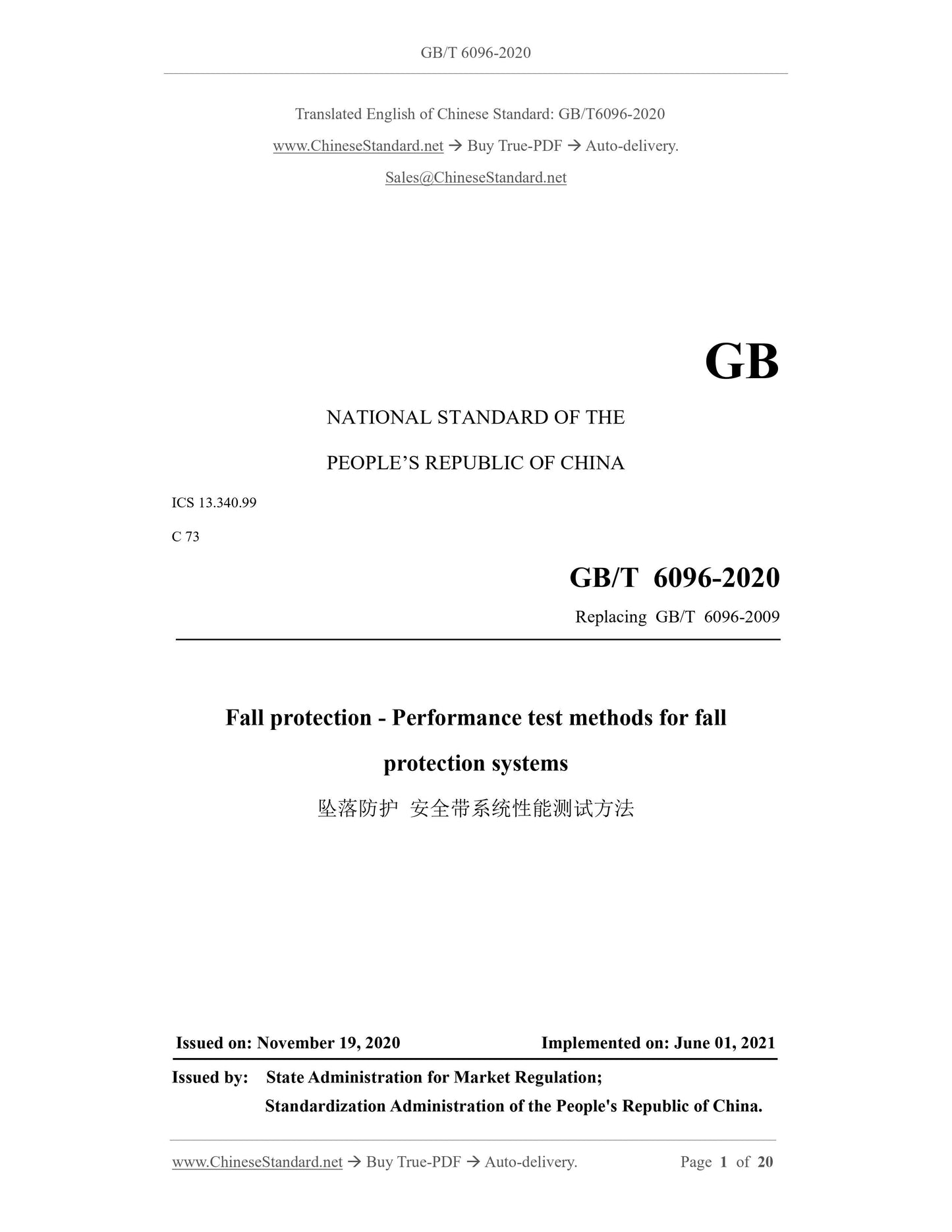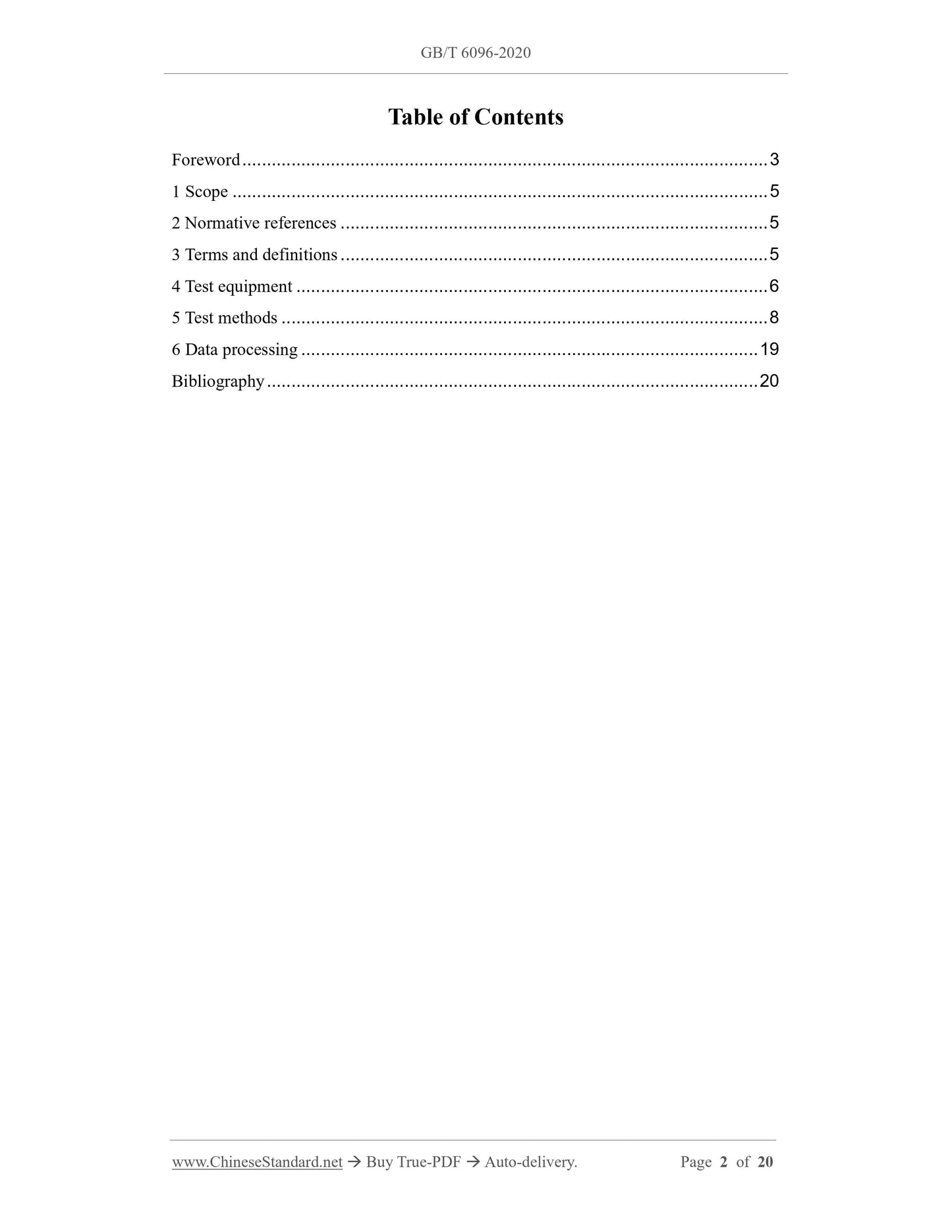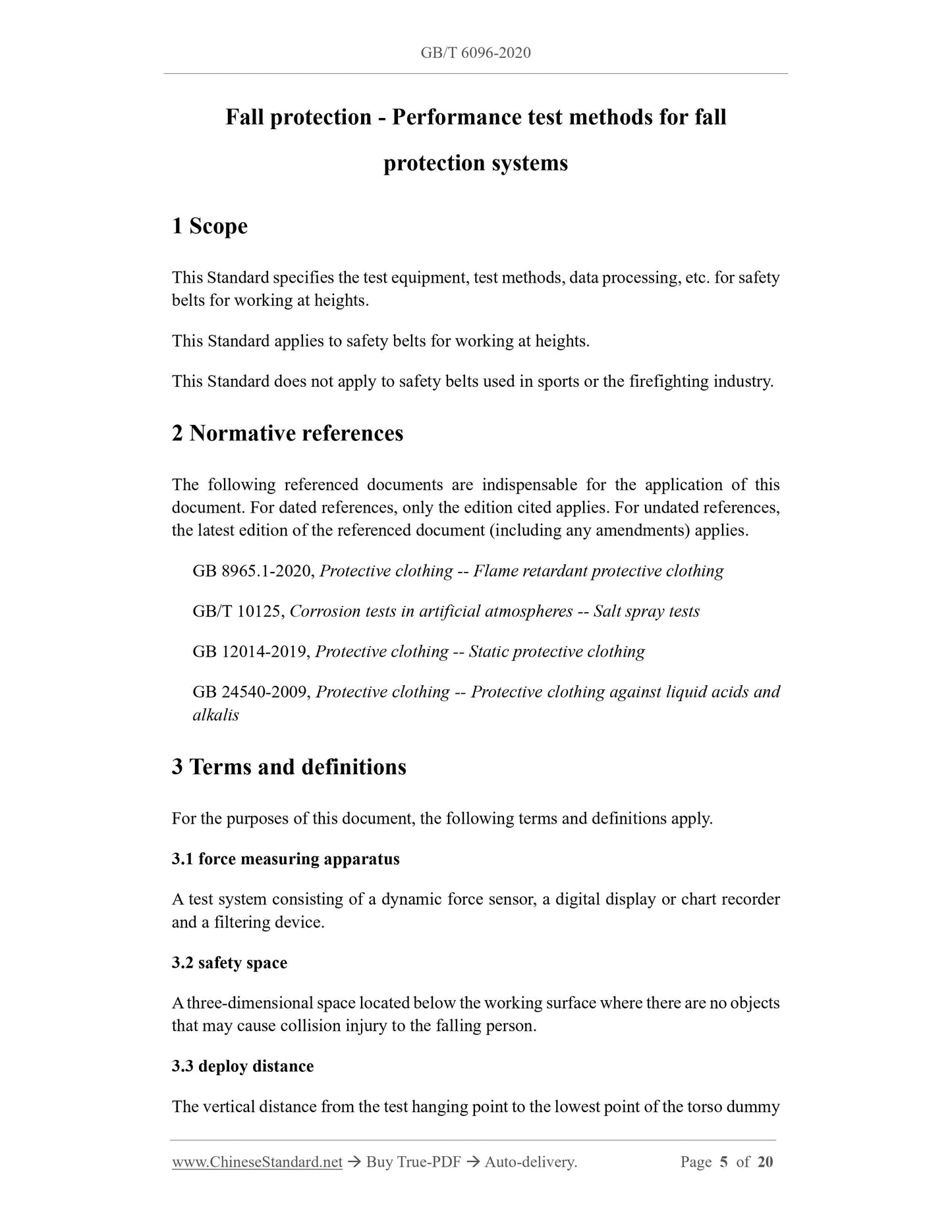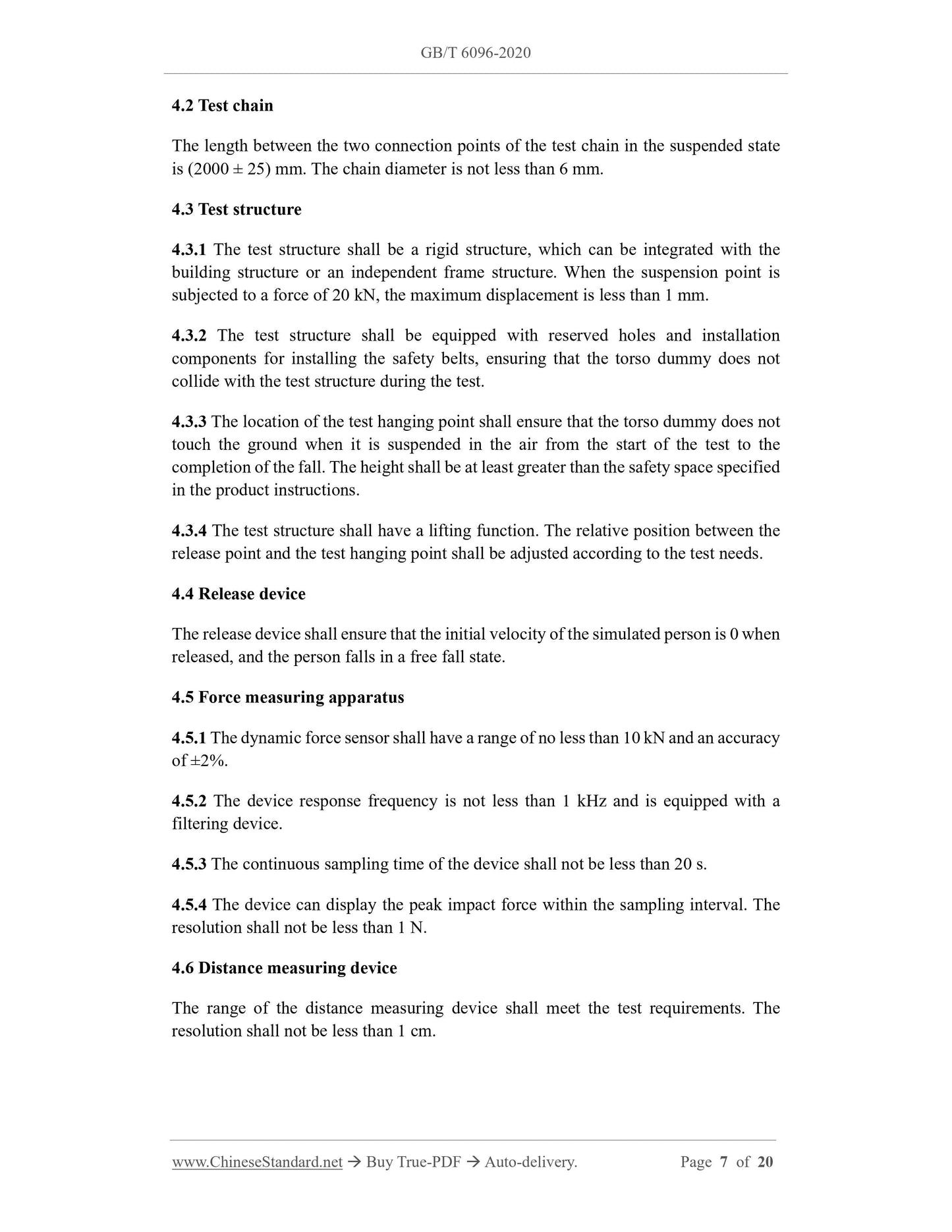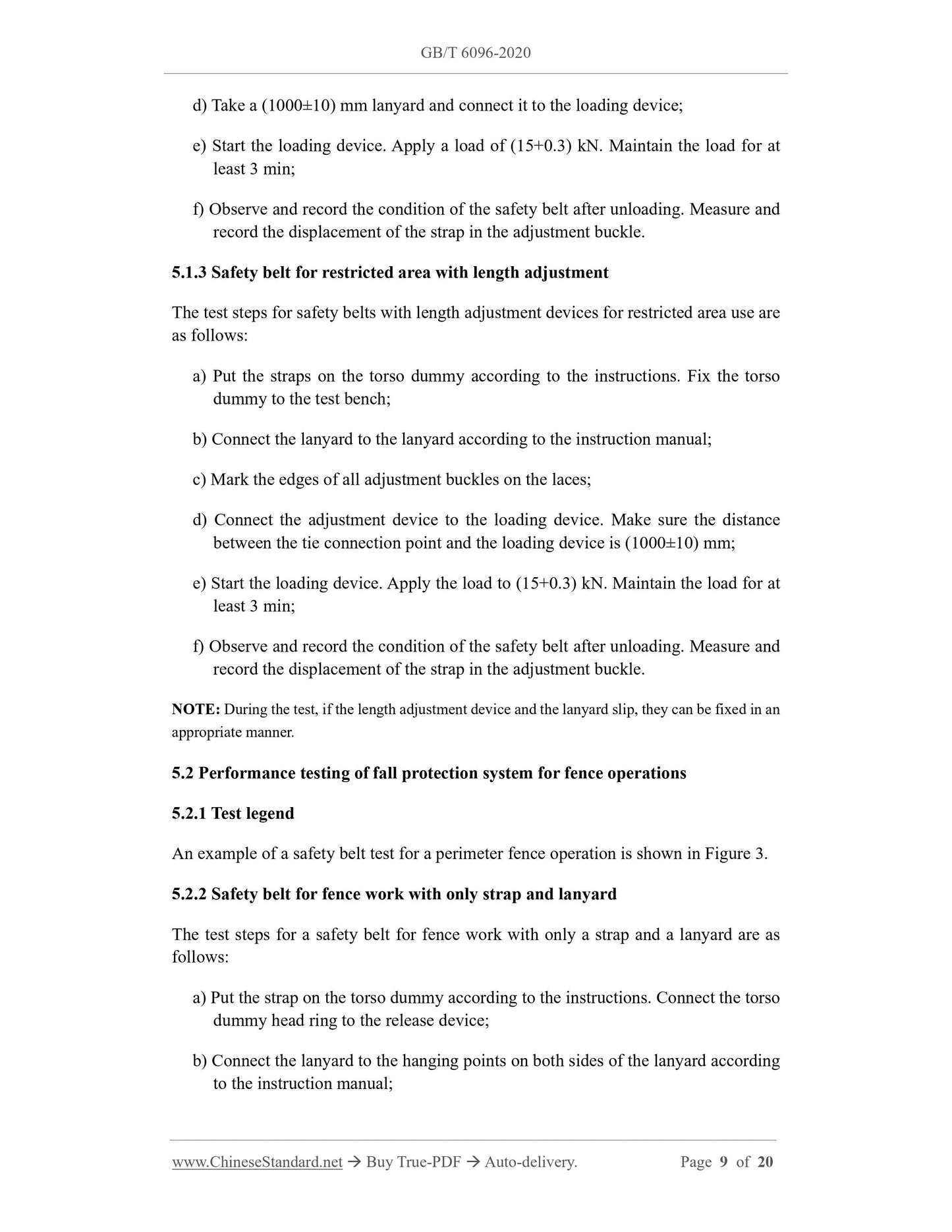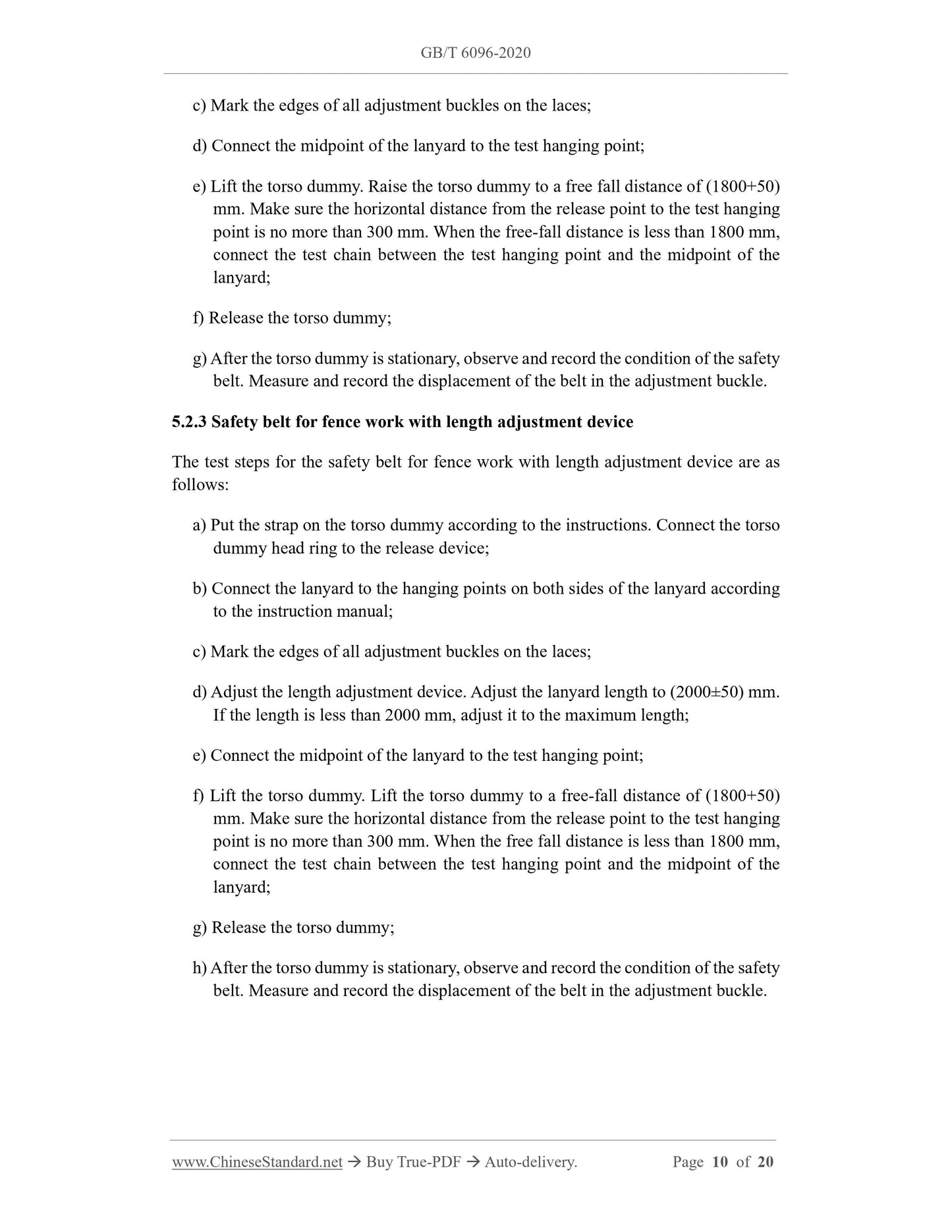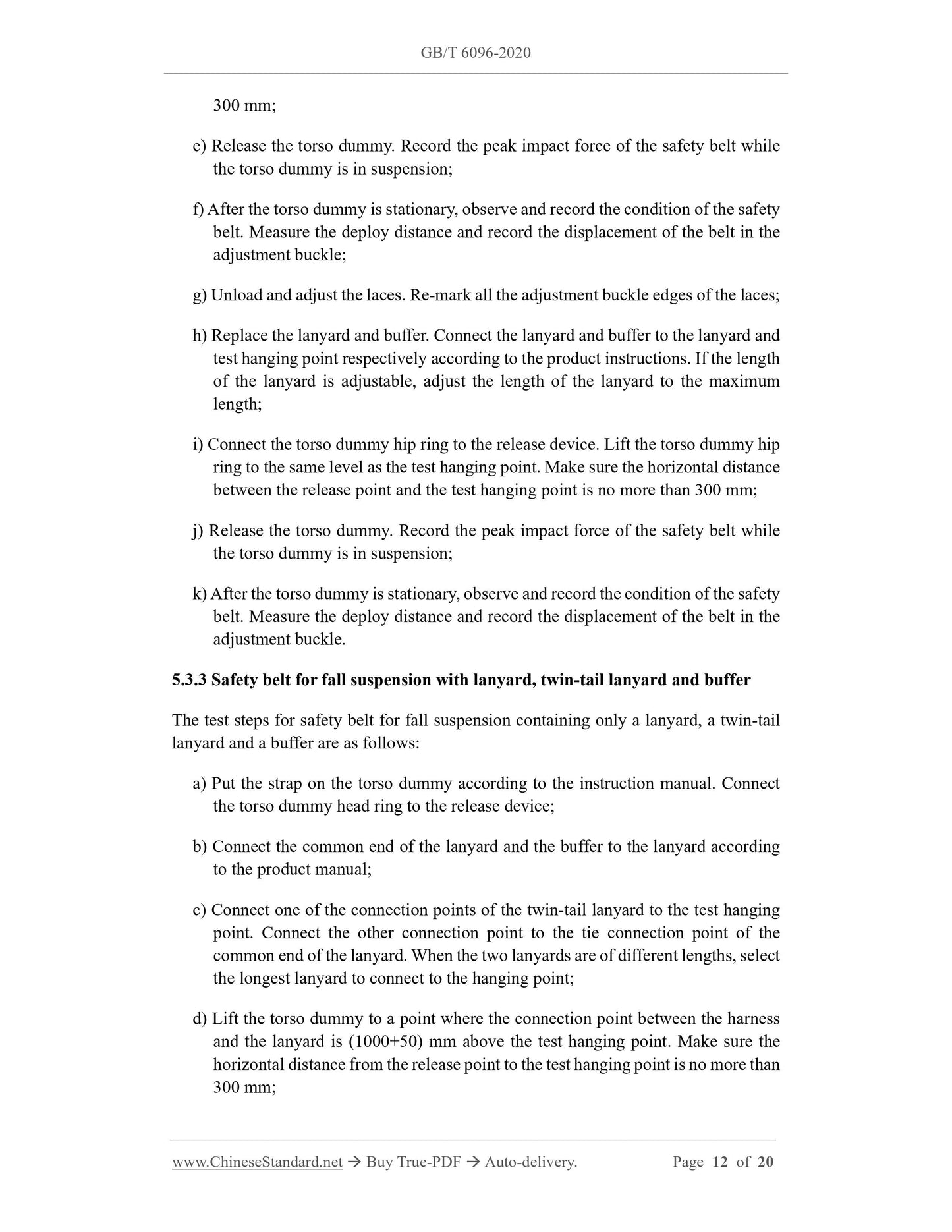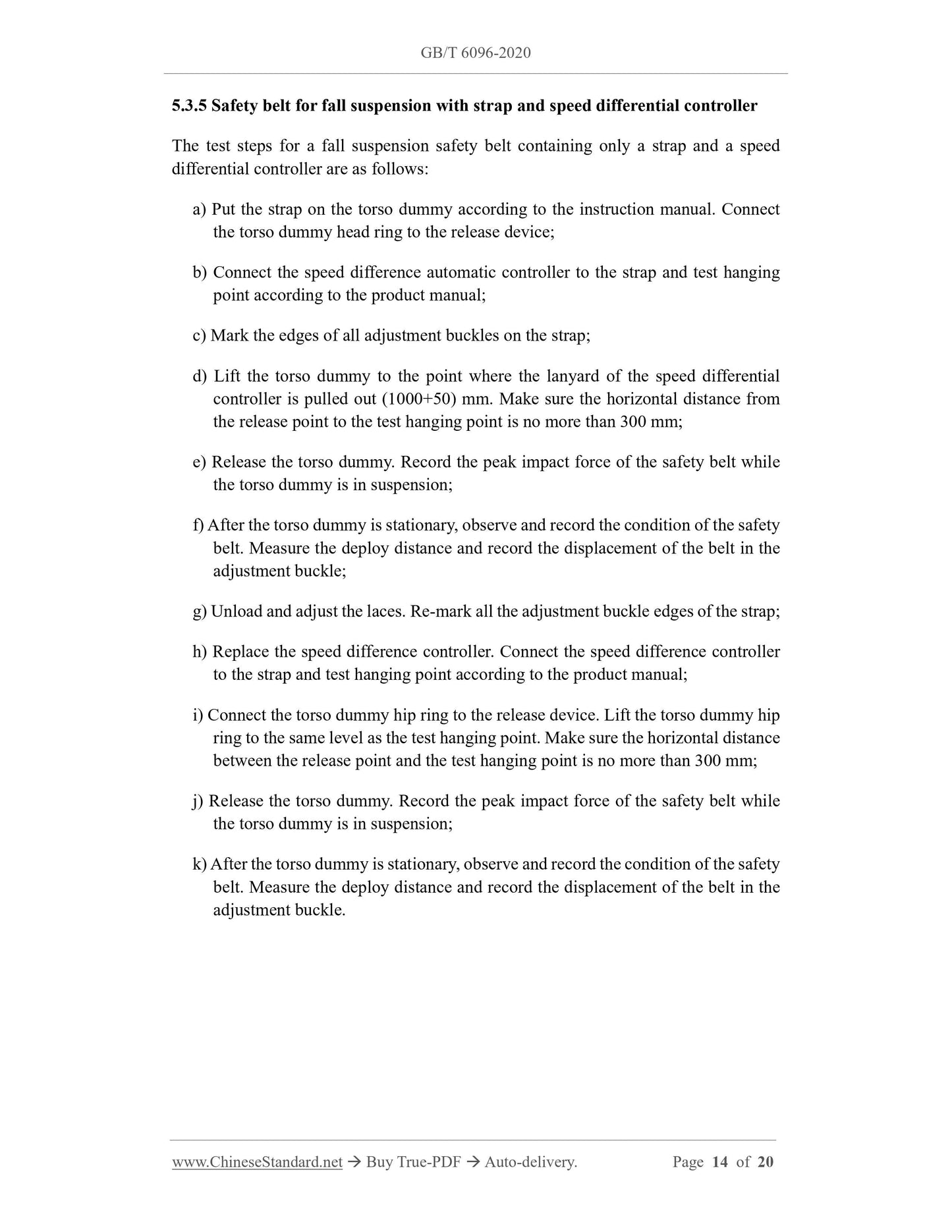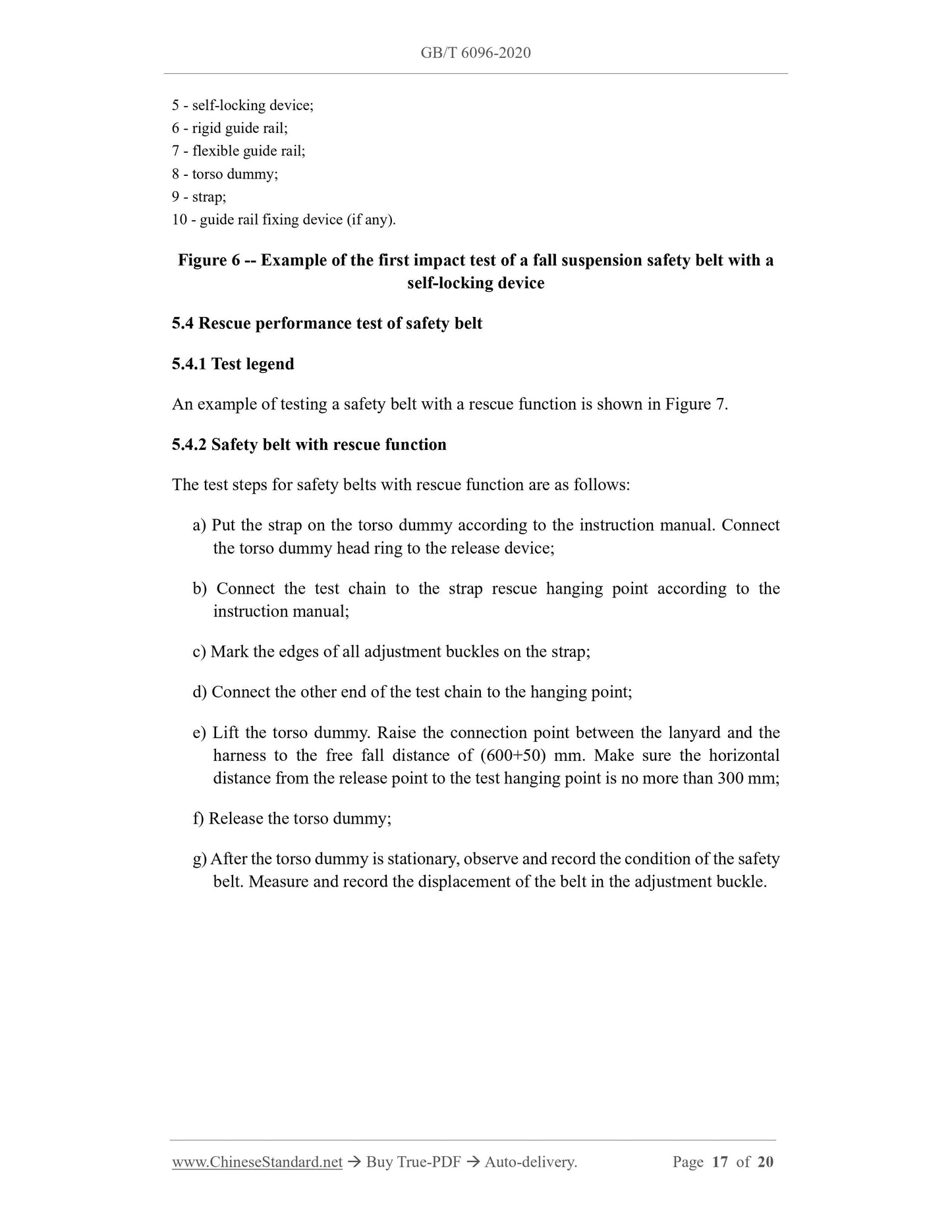1
/
of
9
www.ChineseStandard.us -- Field Test Asia Pte. Ltd.
GB/T 6096-2020 English PDF (GB/T6096-2020)
GB/T 6096-2020 English PDF (GB/T6096-2020)
Regular price
$235.00
Regular price
Sale price
$235.00
Unit price
/
per
Shipping calculated at checkout.
Couldn't load pickup availability
GB/T 6096-2020: Fall protection - Performance test methods for fall protection systems
Delivery: 9 seconds. Download (& Email) true-PDF + Invoice.
Get Quotation: Click GB/T 6096-2020 (Self-service in 1-minute)
Historical versions (Master-website): GB/T 6096-2020
Preview True-PDF (Reload/Scroll-down if blank)
GB/T 6096-2020
GB
NATIONAL STANDARD OF THE
PEOPLE’S REPUBLIC OF CHINA
ICS 13.340.99
C 73
Replacing GB/T 6096-2009
Fall protection - Performance test methods for fall
protection systems
ISSUED ON: NOVEMBER 19, 2020
IMPLEMENTED ON: JUNE 01, 2021
Issued by: State Administration for Market Regulation;
Standardization Administration of the People's Republic of China.
Table of Contents
Foreword ... 3
1 Scope ... 5
2 Normative references ... 5
3 Terms and definitions ... 5
4 Test equipment ... 6
5 Test methods ... 8
6 Data processing ... 19
Bibliography ... 20
Fall protection - Performance test methods for fall
protection systems
1 Scope
This Standard specifies the test equipment, test methods, data processing, etc. for safety
belts for working at heights.
This Standard applies to safety belts for working at heights.
This Standard does not apply to safety belts used in sports or the firefighting industry.
2 Normative references
The following referenced documents are indispensable for the application of this
document. For dated references, only the edition cited applies. For undated references,
the latest edition of the referenced document (including any amendments) applies.
GB 8965.1-2020, Protective clothing -- Flame retardant protective clothing
GB/T 10125, Corrosion tests in artificial atmospheres -- Salt spray tests
GB 12014-2019, Protective clothing -- Static protective clothing
GB 24540-2009, Protective clothing -- Protective clothing against liquid acids and
alkalis
3 Terms and definitions
For the purposes of this document, the following terms and definitions apply.
3.1 force measuring apparatus
A test system consisting of a dynamic force sensor, a digital display or chart recorder
and a filtering device.
3.2 safety space
A three-dimensional space located below the working surface where there are no objects
that may cause collision injury to the falling person.
3.3 deploy distance
The vertical distance from the test hanging point to the lowest point of the torso dummy
4.2 Test chain
The length between the two connection points of the test chain in the suspended state
is (2000 ± 25) mm. The chain diameter is not less than 6 mm.
4.3 Test structure
4.3.1 The test structure shall be a rigid structure, which can be integrated with the
building structure or an independent frame structure. When the suspension point is
subjected to a force of 20 kN, the maximum displacement is less than 1 mm.
4.3.2 The test structure shall be equipped with reserved holes and installation
components for installing the safety belts, ensuring that the torso dummy does not
collide with the test structure during the test.
4.3.3 The location of the test hanging point shall ensure that the torso dummy does not
touch the ground when it is suspended in the air from the start of the test to the
completion of the fall. The height shall be at least greater than the safety space specified
in the product instructions.
4.3.4 The test structure shall have a lifting function. The relative position between the
release point and the test hanging point shall be adjusted according to the test needs.
4.4 Release device
The release device shall ensure that the initial velocity of the simulated person is 0 when
released, and the person falls in a free fall state.
4.5 Force measuring apparatus
4.5.1 The dynamic force sensor shall have a range of no less than 10 kN and an accuracy
of ±2%.
4.5.2 The device response frequency is not less than 1 kHz and is equipped with a
filtering device.
4.5.3 The continuous sampling time of the device shall not be less than 20 s.
4.5.4 The device can display the peak impact force within the sampling interval. The
resolution shall not be less than 1 N.
4.6 Distance measuring device
The range of the distance measuring device shall meet the test requirements. The
resolution shall not be less than 1 cm.
d) Take a (1000±10) mm lanyard and connect it to the loading device;
e) Start the loading device. Apply a load of (15+0.3) kN. Maintain the load for at
least 3 min;
f) Observe and record the condition of the safety belt after unloading. Measure and
record the displacement of the strap in the adjustment buckle.
5.1.3 Safety belt for restricted area with length adjustment
The test steps for safety belts with length adjustment devices for restricted area use are
as follows:
a) Put the straps on the torso dummy according to the instructions. Fix the torso
dummy to the test bench;
b) Connect the lanyard to the lanyard according to the instruction manual;
c) Mark the edges of all adjustment buckles on the laces;
d) Connect the adjustment device to the loading device. Make sure the distance
between the tie connection point and the loading device is (1000±10) mm;
e) Start the loading device. Apply the load to (15+0.3) kN. Maintain the load for at
least 3 min;
f) Observe and record the condition of the safety belt after unloading. Measure and
record the displacement of the strap in the adjustment buckle.
NOTE: During the test, if the length adjustment device and the lanyard slip, they can be fixed in an
appropriate manner.
5.2 Performance testing of fall protection system for fence operations
5.2.1 Test legend
An example of a safety belt test for a perimeter fence operation is shown in Figure 3.
5.2.2 Safety belt for fence work with only strap and lanyard
The test steps for a safety belt for fence work with only a strap and a lanyard are as
follows:
a) Put the strap on the torso dummy according to the instructions. Connect the torso
dummy head ring to the release device;
b) Connect the lanyard to the hanging points on both sides of the lanyard according
to the instruction manual;
c) Mark the edges of all adjustment buckles on the laces;
d) Connect the midpoint of the lanyard to the test hanging point;
e) Lift the torso dummy. Raise the torso dummy to a free fall distance of (1800+50)
mm. Make sure the horizontal distance from the release point to the test hanging
point is no more than 300 mm. When the free-fall distance is less than 1800 mm,
connect the test chain between the test hanging point and the midpoint of the
lanyard;
f) Release the torso dummy;
g) After the torso dummy is stationary, observe and record the condition of the safety
belt. Measure and record the displacement of the belt in the adjustment buckle.
5.2.3 Safety belt for fence work with length adjustment device
The test steps for the safety belt for fence work with length adjustment device are as
follows:
a) Put the strap on the torso dummy according to the instructions. Connect the torso
dummy head ring to the release device;
b) Connect the lanyard to the hanging points on both sides of the lanyard according
to the instruction manual;
c) Mark the edges of all adjustment buckles on the laces;
d) Adjust the length adjustment device. Adjust the lanyard length to (2000±50) mm.
If the length is less than 2000 mm, adjust it to the maximum length;
e) Connect the midpoint of the lanyard to the test hanging point;
f) Lift the torso dummy. Lift the torso dummy to a free-fall distance of (1800+50)
mm. Make sure the horizontal distance from the release point to the test hanging
point is no more than 300 mm. When the free fall distance is less than 1800 mm,
connect the test chain between the test hanging point and the midpoint of the
lanyard;
g) Release the torso dummy;
h) After the torso dummy is stationary, observe and record the condition of the safety
belt. Measure and record the displacement of the belt in the adjustment buckle.
300 mm;
e) Release the torso dummy. Record the peak impact force of the safety belt while
the torso dummy is in suspension;
f) After the torso dummy is stationary, observe and record the condition of the safety
belt. Measure the deploy distance and record the displacement of the belt in the
adjustment buckle;
g) Unload and adjust the laces. Re-mark all the adjustment buckle edges of the laces;
h) Replace the lanyard and buffer. Connect the lanyard and buffer to the lanyard and
test hanging point respectively according to the product instructions. If the length
of the lanyard is adjustable, adjust the length of the lanyard to the maximum
length;
i) Connect the torso dummy hip ring to the release device. Lift the torso dummy hip
ring to the same level as the test hanging point. Make sure the horizontal distance
between the release point and the test hanging point is no more than 300 mm;
j) Release the torso dummy. Record the peak impact force of the safety belt while
the torso dummy is in suspension;
k) After the torso dummy is stationary, observe and record the condition of the safety
belt. Measure the deploy distance and record the displacement of the belt in the
adjustment buckle.
5.3.3 Safety belt for fall suspension with lanyard, twin-tail lanyard and buffer
The test steps for safety belt for fall suspension containing only a lanyard, a twin-tail
lanyard and a buffer are as follows:
a) Put the strap on the torso dummy according to the instruction manual. Connect
the torso dummy head ring to the release device;
b) Connect the common end of the lanyard and the buffer to the lanyard according
to the product manual;
c) Connect one of the connection points of the twin-tail lanyard to the test hanging
point. Connect the other connection point to the tie connection point of the
common end of the lanyard. When the two lanyards are of different lengths, select
the longest lanyard to connect to the hanging point;
d) Lift the torso dummy to a point where the connection point between the harness
and the lanyard is (1000+50) mm above the test hanging point. Make sure the
horizontal distance from the release point to the test hanging point is no more than
300 mm;
5.3.5 Safety belt for fall suspension with strap and speed differential controller
The test steps for a fall suspension safety belt containing only a strap and a speed
differential controller are as follows:
a) Put the strap on the torso dummy according to the instruction manual. Connect
the torso dummy head ring to the release device;
b) Connect the speed difference automatic controller to the strap and test hanging
point according to the product manual;
c) Mark the edges of all adjustment buckles on the strap;
d) Lift the torso dummy to the point where the lanyard of the speed differential
controller is pulled out (1000+50) mm. Make sure the horizontal distance from
the release point to the test hanging point is no more than 300 mm;
e) Release the torso dummy. Record the peak impact force of the safety belt while
the torso dummy is in suspension;
f) After the torso dummy is stationary, observe and record the condition of the safety
belt. Measure the deploy distance and record the displacement of the belt in the
adjustment buckle;
g) Unload and adjust the laces. Re-mark all the adjustment buckle edges of the strap;
h) Replace the speed difference controller. Connect the speed difference controller
to the strap and test hanging point according to the product manual;
i) Connect the torso dummy hip ring to the release device. Lift the torso dummy hip
ring to the same level as the test hanging point. Make sure the horizontal distance
between the release point and the test hanging point is no more than 300 mm;
j) Release the torso dummy. Record the peak impact force of the safety belt while
the torso dummy is in suspension;
k) After the torso dummy is stationary, observe and record the condition of the safety
belt. Measure the deploy distance and record the displacement of the belt in the
adjustment buckle.
5 - self-locking device;
6 - rigid guide rail;
7 - flexible guide rail;
8 - torso dummy;
9 - strap;
10 - guide rail fixing device (if any).
Figure 6 -- Example of the first impact test of a fall suspension safety belt with a
self-locking device
5.4 Rescue performance test of safety belt
5.4.1 Test legend
An example of testing a safety belt with a rescue function is shown in Figure 7.
5.4.2 Safety belt with rescue function
The test steps for safety belts with rescue function are as follows:
a) Put the strap on the torso dummy according to the instruction manual. Connect
the torso dummy head ring to the release device;
b) Connect the test chain to the strap rescue hanging point according to the
instruction manual;
c) Mark the edges of all adjustment buckles on the strap;
d) Connect the other end of the test chain to the hanging point;
e) Lift the torso dummy. Raise the connection point between the lanyard and the
harness to the free fall distance of (600+50) mm. Make sure the horizontal
distance from the release point to the test hanging point is no more than 300 mm;
f) Release the torso dummy;
g) After the torso dummy is stationary, observe and record the condition of the safety
belt. Measure and record the displacement of the belt in the adjustment buckle.
GB/T 6096-2020
GB
NATIONAL STANDARD OF THE
PEOPLE’S REPUBLIC OF CHINA
ICS 13.340.99
C 73
Replacing GB/T 6096-2009
Fall protection - Performance test methods for fall
protection systems
ISSUED ON: NOVEMBER 19, 2020
IMPLEMENTED ON: JUNE 01, 2021
Issued by: State Administration for Market Regulation;
Standardization Administration of the People's Republic of China.
Table of Contents
Foreword ... 3
1 Scope ... 5
2 Normative references ... 5
3 Terms and definitions ... 5
4 Test equipment ... 6
5 Test methods ... 8
6 Data processing ... 19
Bibliography ... 20
Fall protection - Performance test methods for fall
protection systems
1 Scope
This Standard specifies the test equipment, test methods, data processing, etc. for safety
belts for working at heights.
This Standard applies to safety belts for working at heights.
This Standard does not apply to safety belts used in sports or the firefighting industry.
2 Normative references...
Delivery: 9 seconds. Download (& Email) true-PDF + Invoice.
Get Quotation: Click GB/T 6096-2020 (Self-service in 1-minute)
Historical versions (Master-website): GB/T 6096-2020
Preview True-PDF (Reload/Scroll-down if blank)
GB/T 6096-2020
GB
NATIONAL STANDARD OF THE
PEOPLE’S REPUBLIC OF CHINA
ICS 13.340.99
C 73
Replacing GB/T 6096-2009
Fall protection - Performance test methods for fall
protection systems
ISSUED ON: NOVEMBER 19, 2020
IMPLEMENTED ON: JUNE 01, 2021
Issued by: State Administration for Market Regulation;
Standardization Administration of the People's Republic of China.
Table of Contents
Foreword ... 3
1 Scope ... 5
2 Normative references ... 5
3 Terms and definitions ... 5
4 Test equipment ... 6
5 Test methods ... 8
6 Data processing ... 19
Bibliography ... 20
Fall protection - Performance test methods for fall
protection systems
1 Scope
This Standard specifies the test equipment, test methods, data processing, etc. for safety
belts for working at heights.
This Standard applies to safety belts for working at heights.
This Standard does not apply to safety belts used in sports or the firefighting industry.
2 Normative references
The following referenced documents are indispensable for the application of this
document. For dated references, only the edition cited applies. For undated references,
the latest edition of the referenced document (including any amendments) applies.
GB 8965.1-2020, Protective clothing -- Flame retardant protective clothing
GB/T 10125, Corrosion tests in artificial atmospheres -- Salt spray tests
GB 12014-2019, Protective clothing -- Static protective clothing
GB 24540-2009, Protective clothing -- Protective clothing against liquid acids and
alkalis
3 Terms and definitions
For the purposes of this document, the following terms and definitions apply.
3.1 force measuring apparatus
A test system consisting of a dynamic force sensor, a digital display or chart recorder
and a filtering device.
3.2 safety space
A three-dimensional space located below the working surface where there are no objects
that may cause collision injury to the falling person.
3.3 deploy distance
The vertical distance from the test hanging point to the lowest point of the torso dummy
4.2 Test chain
The length between the two connection points of the test chain in the suspended state
is (2000 ± 25) mm. The chain diameter is not less than 6 mm.
4.3 Test structure
4.3.1 The test structure shall be a rigid structure, which can be integrated with the
building structure or an independent frame structure. When the suspension point is
subjected to a force of 20 kN, the maximum displacement is less than 1 mm.
4.3.2 The test structure shall be equipped with reserved holes and installation
components for installing the safety belts, ensuring that the torso dummy does not
collide with the test structure during the test.
4.3.3 The location of the test hanging point shall ensure that the torso dummy does not
touch the ground when it is suspended in the air from the start of the test to the
completion of the fall. The height shall be at least greater than the safety space specified
in the product instructions.
4.3.4 The test structure shall have a lifting function. The relative position between the
release point and the test hanging point shall be adjusted according to the test needs.
4.4 Release device
The release device shall ensure that the initial velocity of the simulated person is 0 when
released, and the person falls in a free fall state.
4.5 Force measuring apparatus
4.5.1 The dynamic force sensor shall have a range of no less than 10 kN and an accuracy
of ±2%.
4.5.2 The device response frequency is not less than 1 kHz and is equipped with a
filtering device.
4.5.3 The continuous sampling time of the device shall not be less than 20 s.
4.5.4 The device can display the peak impact force within the sampling interval. The
resolution shall not be less than 1 N.
4.6 Distance measuring device
The range of the distance measuring device shall meet the test requirements. The
resolution shall not be less than 1 cm.
d) Take a (1000±10) mm lanyard and connect it to the loading device;
e) Start the loading device. Apply a load of (15+0.3) kN. Maintain the load for at
least 3 min;
f) Observe and record the condition of the safety belt after unloading. Measure and
record the displacement of the strap in the adjustment buckle.
5.1.3 Safety belt for restricted area with length adjustment
The test steps for safety belts with length adjustment devices for restricted area use are
as follows:
a) Put the straps on the torso dummy according to the instructions. Fix the torso
dummy to the test bench;
b) Connect the lanyard to the lanyard according to the instruction manual;
c) Mark the edges of all adjustment buckles on the laces;
d) Connect the adjustment device to the loading device. Make sure the distance
between the tie connection point and the loading device is (1000±10) mm;
e) Start the loading device. Apply the load to (15+0.3) kN. Maintain the load for at
least 3 min;
f) Observe and record the condition of the safety belt after unloading. Measure and
record the displacement of the strap in the adjustment buckle.
NOTE: During the test, if the length adjustment device and the lanyard slip, they can be fixed in an
appropriate manner.
5.2 Performance testing of fall protection system for fence operations
5.2.1 Test legend
An example of a safety belt test for a perimeter fence operation is shown in Figure 3.
5.2.2 Safety belt for fence work with only strap and lanyard
The test steps for a safety belt for fence work with only a strap and a lanyard are as
follows:
a) Put the strap on the torso dummy according to the instructions. Connect the torso
dummy head ring to the release device;
b) Connect the lanyard to the hanging points on both sides of the lanyard according
to the instruction manual;
c) Mark the edges of all adjustment buckles on the laces;
d) Connect the midpoint of the lanyard to the test hanging point;
e) Lift the torso dummy. Raise the torso dummy to a free fall distance of (1800+50)
mm. Make sure the horizontal distance from the release point to the test hanging
point is no more than 300 mm. When the free-fall distance is less than 1800 mm,
connect the test chain between the test hanging point and the midpoint of the
lanyard;
f) Release the torso dummy;
g) After the torso dummy is stationary, observe and record the condition of the safety
belt. Measure and record the displacement of the belt in the adjustment buckle.
5.2.3 Safety belt for fence work with length adjustment device
The test steps for the safety belt for fence work with length adjustment device are as
follows:
a) Put the strap on the torso dummy according to the instructions. Connect the torso
dummy head ring to the release device;
b) Connect the lanyard to the hanging points on both sides of the lanyard according
to the instruction manual;
c) Mark the edges of all adjustment buckles on the laces;
d) Adjust the length adjustment device. Adjust the lanyard length to (2000±50) mm.
If the length is less than 2000 mm, adjust it to the maximum length;
e) Connect the midpoint of the lanyard to the test hanging point;
f) Lift the torso dummy. Lift the torso dummy to a free-fall distance of (1800+50)
mm. Make sure the horizontal distance from the release point to the test hanging
point is no more than 300 mm. When the free fall distance is less than 1800 mm,
connect the test chain between the test hanging point and the midpoint of the
lanyard;
g) Release the torso dummy;
h) After the torso dummy is stationary, observe and record the condition of the safety
belt. Measure and record the displacement of the belt in the adjustment buckle.
300 mm;
e) Release the torso dummy. Record the peak impact force of the safety belt while
the torso dummy is in suspension;
f) After the torso dummy is stationary, observe and record the condition of the safety
belt. Measure the deploy distance and record the displacement of the belt in the
adjustment buckle;
g) Unload and adjust the laces. Re-mark all the adjustment buckle edges of the laces;
h) Replace the lanyard and buffer. Connect the lanyard and buffer to the lanyard and
test hanging point respectively according to the product instructions. If the length
of the lanyard is adjustable, adjust the length of the lanyard to the maximum
length;
i) Connect the torso dummy hip ring to the release device. Lift the torso dummy hip
ring to the same level as the test hanging point. Make sure the horizontal distance
between the release point and the test hanging point is no more than 300 mm;
j) Release the torso dummy. Record the peak impact force of the safety belt while
the torso dummy is in suspension;
k) After the torso dummy is stationary, observe and record the condition of the safety
belt. Measure the deploy distance and record the displacement of the belt in the
adjustment buckle.
5.3.3 Safety belt for fall suspension with lanyard, twin-tail lanyard and buffer
The test steps for safety belt for fall suspension containing only a lanyard, a twin-tail
lanyard and a buffer are as follows:
a) Put the strap on the torso dummy according to the instruction manual. Connect
the torso dummy head ring to the release device;
b) Connect the common end of the lanyard and the buffer to the lanyard according
to the product manual;
c) Connect one of the connection points of the twin-tail lanyard to the test hanging
point. Connect the other connection point to the tie connection point of the
common end of the lanyard. When the two lanyards are of different lengths, select
the longest lanyard to connect to the hanging point;
d) Lift the torso dummy to a point where the connection point between the harness
and the lanyard is (1000+50) mm above the test hanging point. Make sure the
horizontal distance from the release point to the test hanging point is no more than
300 mm;
5.3.5 Safety belt for fall suspension with strap and speed differential controller
The test steps for a fall suspension safety belt containing only a strap and a speed
differential controller are as follows:
a) Put the strap on the torso dummy according to the instruction manual. Connect
the torso dummy head ring to the release device;
b) Connect the speed difference automatic controller to the strap and test hanging
point according to the product manual;
c) Mark the edges of all adjustment buckles on the strap;
d) Lift the torso dummy to the point where the lanyard of the speed differential
controller is pulled out (1000+50) mm. Make sure the horizontal distance from
the release point to the test hanging point is no more than 300 mm;
e) Release the torso dummy. Record the peak impact force of the safety belt while
the torso dummy is in suspension;
f) After the torso dummy is stationary, observe and record the condition of the safety
belt. Measure the deploy distance and record the displacement of the belt in the
adjustment buckle;
g) Unload and adjust the laces. Re-mark all the adjustment buckle edges of the strap;
h) Replace the speed difference controller. Connect the speed difference controller
to the strap and test hanging point according to the product manual;
i) Connect the torso dummy hip ring to the release device. Lift the torso dummy hip
ring to the same level as the test hanging point. Make sure the horizontal distance
between the release point and the test hanging point is no more than 300 mm;
j) Release the torso dummy. Record the peak impact force of the safety belt while
the torso dummy is in suspension;
k) After the torso dummy is stationary, observe and record the condition of the safety
belt. Measure the deploy distance and record the displacement of the belt in the
adjustment buckle.
5 - self-locking device;
6 - rigid guide rail;
7 - flexible guide rail;
8 - torso dummy;
9 - strap;
10 - guide rail fixing device (if any).
Figure 6 -- Example of the first impact test of a fall suspension safety belt with a
self-locking device
5.4 Rescue performance test of safety belt
5.4.1 Test legend
An example of testing a safety belt with a rescue function is shown in Figure 7.
5.4.2 Safety belt with rescue function
The test steps for safety belts with rescue function are as follows:
a) Put the strap on the torso dummy according to the instruction manual. Connect
the torso dummy head ring to the release device;
b) Connect the test chain to the strap rescue hanging point according to the
instruction manual;
c) Mark the edges of all adjustment buckles on the strap;
d) Connect the other end of the test chain to the hanging point;
e) Lift the torso dummy. Raise the connection point between the lanyard and the
harness to the free fall distance of (600+50) mm. Make sure the horizontal
distance from the release point to the test hanging point is no more than 300 mm;
f) Release the torso dummy;
g) After the torso dummy is stationary, observe and record the condition of the safety
belt. Measure and record the displacement of the belt in the adjustment buckle.
GB/T 6096-2020
GB
NATIONAL STANDARD OF THE
PEOPLE’S REPUBLIC OF CHINA
ICS 13.340.99
C 73
Replacing GB/T 6096-2009
Fall protection - Performance test methods for fall
protection systems
ISSUED ON: NOVEMBER 19, 2020
IMPLEMENTED ON: JUNE 01, 2021
Issued by: State Administration for Market Regulation;
Standardization Administration of the People's Republic of China.
Table of Contents
Foreword ... 3
1 Scope ... 5
2 Normative references ... 5
3 Terms and definitions ... 5
4 Test equipment ... 6
5 Test methods ... 8
6 Data processing ... 19
Bibliography ... 20
Fall protection - Performance test methods for fall
protection systems
1 Scope
This Standard specifies the test equipment, test methods, data processing, etc. for safety
belts for working at heights.
This Standard applies to safety belts for working at heights.
This Standard does not apply to safety belts used in sports or the firefighting industry.
2 Normative references...
Share
